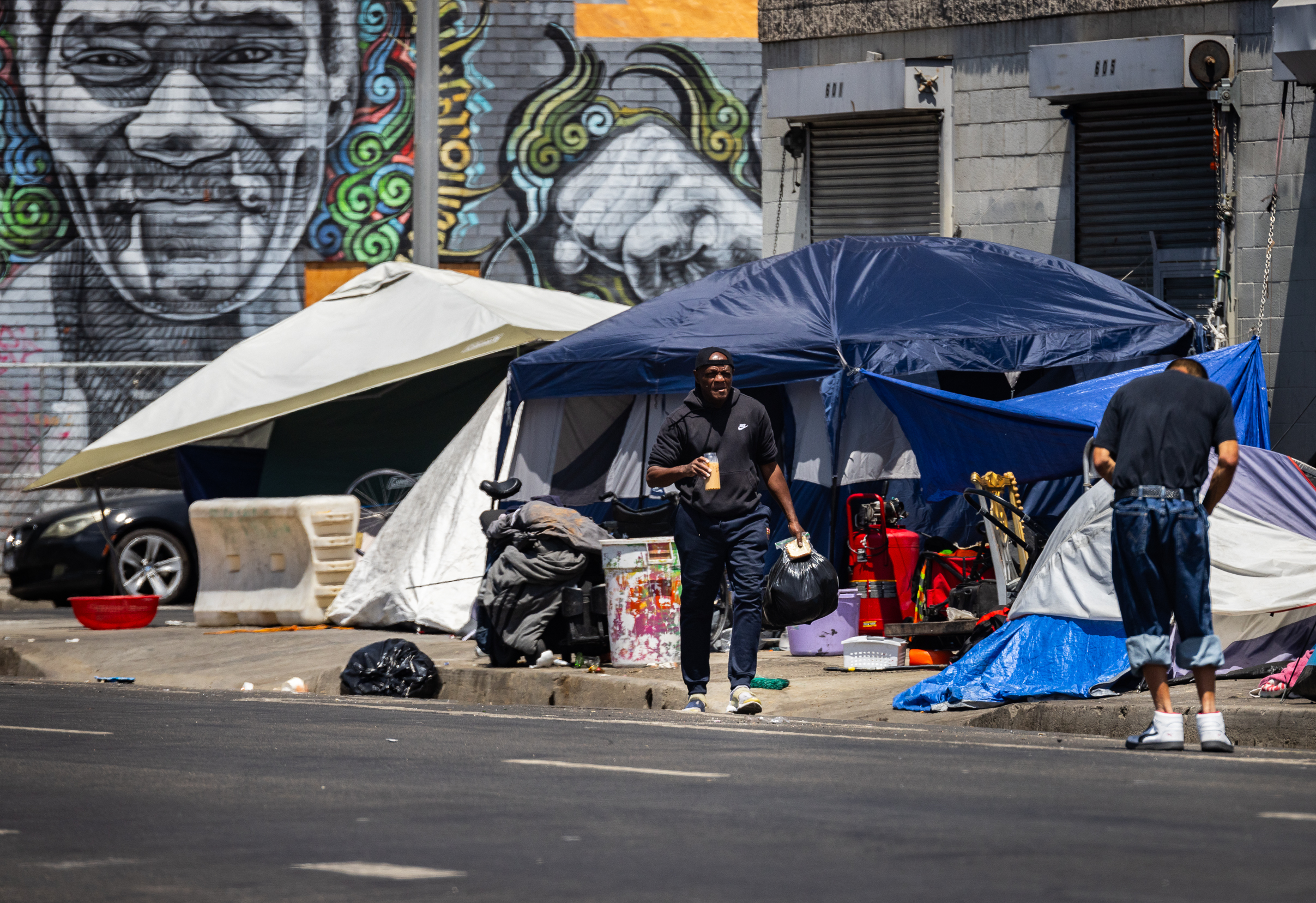Local governments and organizations across California will be granted a slice of $827 million in state funding to better connect homeless people with shelters and services, Gov. Gavin Newsom announced in an Oct. 29 statement.
The governor, joined by Los Angeles Mayor Karen Bass, said 37 regional recipients will disburse the funds to 100 local communities and organizations statewide to create new housing, shelter, and support for those experiencing homelessness.
Newsom said the new funds are tied to “strong accountability measures and reporting requirements” that aim to track expenses and measure outcomes.
A state audit report in April showed that California spent $24 billion on homelessness in the last five fiscal years, but didn’t regularly track outcomes.
To be eligible for the new funds, recipients had to agree to enhanced accountability, transparency, and compliance measures.
“The state has stepped up in ways the state has never stepped up in the past,” Newsom said at a news conference.
The new funds are part of California’s Homeless Housing and Assistance Prevention (HHAP) grant program, which is administered by the California Department of Housing and Community Development (HCD).
To receive the HHAP funds, grantees must commit to addressing racial inequities in homelessness, prioritize permanent housing over temporary shelters, and include people with lived experience of homelessness in planning.
“Our unprecedented commitment to end homelessness can only be realized at the local level when everyone does their part to address this crisis on the streets,” Newsom said.
The nearly $1 billion in new funds pales in comparison with the amount that California has already spent on housing and homelessness programs, including the $24 billion in the last five years.
Earlier this month, Newsom sent local communities $131 million as part of the state’s $1 billion worth of Encampment Resolution Funds to help local governments address homeless camps.
“The accountability in this round of funding ensures we are empowering local partners to design local solutions to prevent and end homelessness, and produce measurable results,” said Business, Consumer Services, and Housing Secretary Tomiquia Moss.
To be eligible for funds, cities, counties, and federal programs known as Continuums of Care were required to commit to work together and make clear who would be responsible for their efforts.
“This will drive coordination and make sure homelessness is solved regionally, not treated as a problem that stops at the city limits,” Newsom’s office said in the statement.
‘Wholly Inadequate’
State Sen. Roger Niello, a Northern California Republican, told The Epoch Times that the goal stated for the new funds is “wholly inadequate.”
While the senator acknowledged that state and local leaders have been “relatively effective” at housing people, they are missing an important piece of the puzzle.
“There are reasons why people have become homeless, and in order to solve their homeless issue, they have to find out,” said Niello, who also served in the state Assembly from 2004 to 2010. “They have to identify the reason, and treat that reason, which is untreated mental illness and untreated substance abuse.” There are other issues, he added, but those are key.
“They didn’t talk about getting people back on their feet and on to self-sufficiency,” Niello said about the governor’s news conference.
“If all they’re going to do is get people under roofs ... if that’s where they’re going to stop, they’re not going to solve homelessness.”
Niello said he’s frustrated wi the state’s lack of focus on self-sufficiency. “I didn’t once hear anybody address the issue of, ‘Why are people homeless?’ Let’s fix why they’re homeless and get them back on their feet and self-sufficient, as opposed to being completely dependent.”
Niello told The Epoch Times that California’s Housing First policy gets in the way of solving the problem. He said the policy dictates that state funding will go to shelter programs, not treatment.
“Treatment is available, if they want it, but if they wanted it, they would have acquired it and gotten off the streets in the first place,” he said. “There has to be an incentive or a motivation or a forcefulness of getting people into treatment. Housing First prevents public funding for any programs that require sobriety as part of their effort to cure homelessness.”
The state ought to allow local governments—in particular at the county level—to create programs that will work for their local areas, he said.
“What you'd find is 58 counties doing potentially 58 different things, some of which will be more successful than others, and the others can learn from [those] that are more effective,” Niello said. “But the state has implemented more or less a top down approach ... and you lose the flexibility of local government with accountability to do what’s going to work best in their communities.”
HCD Director Gustavo Velasquez said in the governor’s statement that the program ensures that every dollar spent is tracked.
“HCD will continue to apply our strong focus on accountability to maximize this critical investment for our state,” he said.
Top 10
The following regions will receive the largest payouts:
- Los Angeles: $380.36 million
- San Diego: $58.84 million
- Santa Clara: $56.77 million
- Alameda: $55.9 million
- Sacramento: $53.21 million
- San Francisco: $43.32 million
- Fresno and Madera: $25.76 million
- Humboldt: $25.76 million
- Riverside: $21.35 million
- San Joaquin: $14.07 million
Full List
- Alameda region: $55.9 million
- Amador, Calaveras, Mariposa, and Tuolumne regions: $2.06 million
- Contra Costa region: $6.68 million
- Del Norte, Lassen, Modoc, Plumas, Shasta, Sierra, and Siskiyou region: $7.1 million
- Fresno and Madera region: $25.76 million
- Humboldt region: $25.76 million
- Imperial region: $3.67 million
- Inyo and Mono region: $247,950
- Kern region: $11.17 million
- Kings and Tulare region: $4.14 million
- Lake region: $1.3 million
- Los Angeles region: $380.36 million
- Marin region: $3.15 million
- Mendocino region: $1.784 million
- Merced region: $2.21 million
- Monterey and San Benito region: $6.23 million
- Napa region: $1.43 million
- Placer region: $1.9 million
- Riverside region: $21.35 million
- Sacramento region: $53.21 million
- San Bernardino region: $11.82 million
- San Diego region: $58.84 million
- San Francisco region: $43.32 million
- San Joaquin region: $14.07 million
- San Luis Obispo region: $4.32 million
- San Mateo region: $5.24 million
- Santa Barbara region: $5.32 million
- Santa Clara region: $56.77 million
- Santa Cruz region: $5.08 million
- Solano region: $3.38 million
- Sonoma region: $6.38 million
- Stanislaus region: $5.89 million
- Tehama region: $856,554
- Ventura region: $6.88 million
- Yolo region: $2.08 million
- Yuba/Sutter region: $1.96 million
- Yuba region: $751,895














